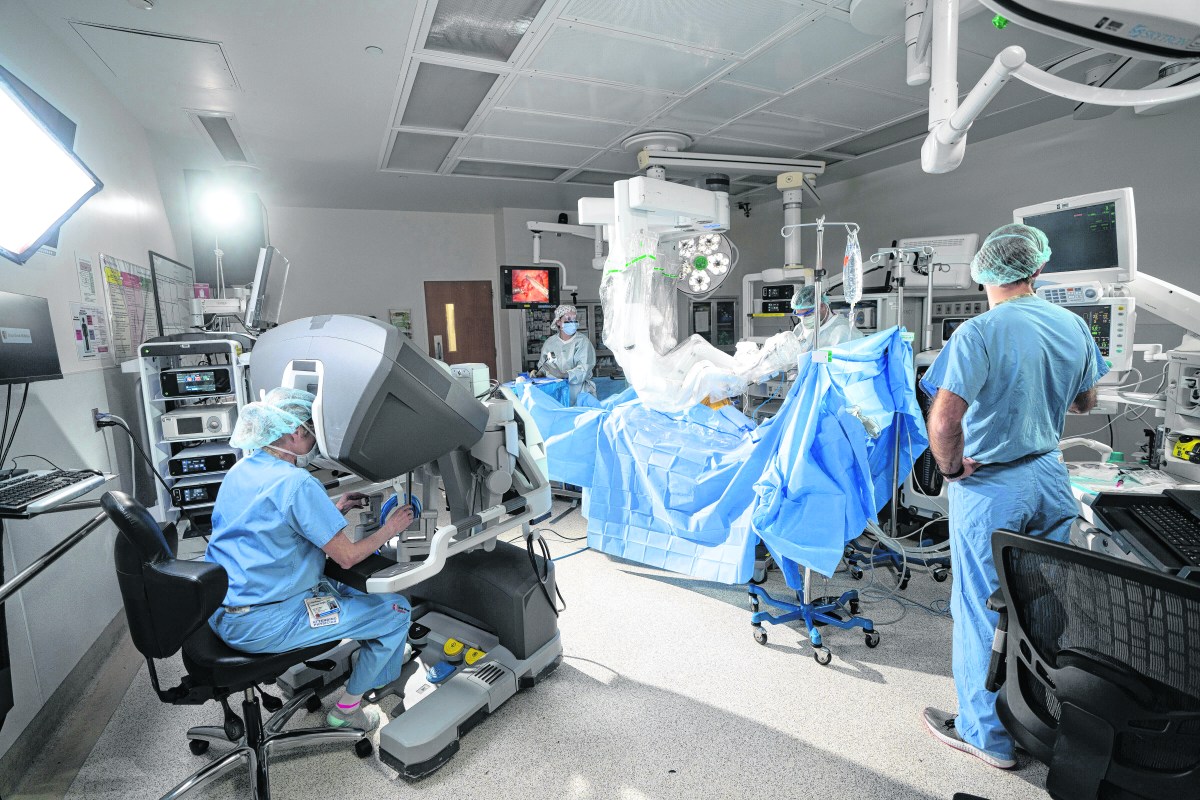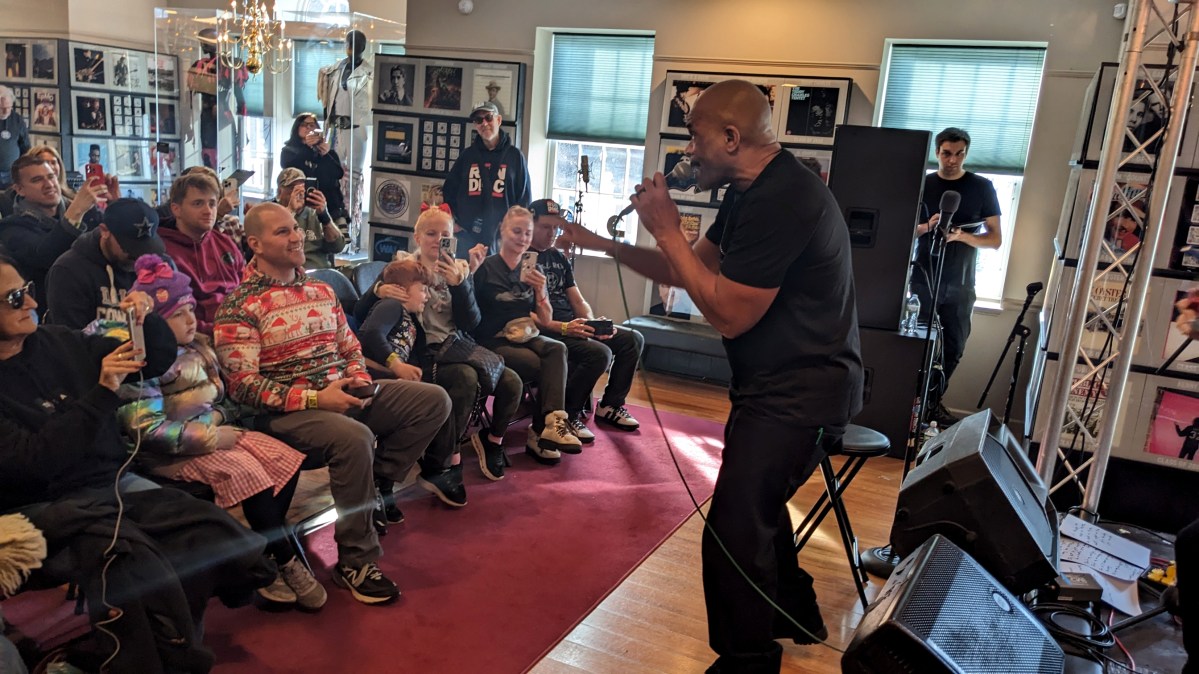When Dr. Ankit Dhamija, cardiothoracic surgeon and director of thoracic robotic surgery at Stony Brook Medicine, did a recent operation, he started by standing near the patient, but not to “operate.” He docked the da Vinci Surgical System robot, made incisions, prepared the patient and set up equipment.
He then took a seat at a console feet away from the patient with a three-dimensional view into the body with magnified images and began operating, using four (up from three in initial versions) robotic arms becoming more common in operating rooms.
“You have clearer visualization,” he said of advances in robotic surgery. “The layout is more user-friendly.”
While surgery for decades changed little, robotics is changing the profession rapidly. The Northwell Cancer Institute recently named Dr. Steven Mitchell Cohen, formerly of NYU Langone, director of robotic pancreas surgery.
“The goal is to convert the more complicated pancreas surgeries to robotic procedures,” Cohen said. “The visual is very impressive since you can see it in 3D.”
Others say we’re still in the early stages of a robotics revolution as surgery goes from traditional to technological.
“I think it’s only the beginning of the integration of robotics and technological advances in the operating room,” said Dr. Gainosuke Sugiyama, chair of Surgery, general surgery, at Long Island Jewish Valley Stream. “Surgeons are seeing benefits with their patients’ outcomes and they’re adopting the technology rapidly.”
TECH TIMES CHANGING
While robotics is changing surgery, doctors say they, not the robotic arms, are in charge. “Every once in a while when I say the word ‘robot,’ patients think the robot will perform the surgery,” Dr. Sugiyama said. “I reassure the patient that I’m the one controlling the instrument.”
Stony Brook’s Chair of the Department of Surgery and Chief of the Division of Vascular and Endovascular Surgery at Stony Brook Medicine Dr. Apostolos Tassiopoulos said tech is a crucial tool.
“It’s still a procedure performed by a surgeon,” Tassiopoulos said. “Although it’s not the traditional vision of the surgeon sitting operating on a patient, the surgeon is operating the system.”
Surgeons who do robotic procedures say robotic arms are more flexible, leading to quicker recoveries and better visuals due to cameras.
“There are more advances in surgery with technology than medical right now,” Dr. Dhamija said, adding Stony Brook has used da Vinci since 2007. “When people hear about an institution with a robotic approach to something, they tend to push themselves to that location.”
The Stryker Mako robot is used in orthopedics, for things such as joint replacement. Medtronic developed the Hugo, approved in much of the world, but still not by the FDA.
Devices typically cost north of $1 million and involve additional materials, leading to financing. Intuitive Surgical, in addition to selling, leases and charges per use.
“Pay-per-use reduces the cost of buying,” Sugiyama said. “That’s one creative thing Intuitive Surgical has done.”
READING, WRITING AND ROBOTICS
The da Vinci lets surgeons perform procedures with more precision, minimal incisions, magnification up to ten times and a full range of motion, surgeons said. Still, robotics has its limits.
“Surgery has a broad spectrum of procedures,” Tassiopoulos added. “Not everything is suitable for a robot.”
He said robotics or “robot-assisted procedures” are best in body cavities such as the abdomen and chest, noting they are used in general, bariatric and thoracic surgery, as well as urology, ENT, colo-rectal, obstetrics and gynecology and other specialties.
“There’s no additional cost to the patient,” Dr. Tassiopoulos said. “There’s a higher cost when you consider the capital equipment and disposables. The patient stays a shorter period of time in the hospital and that helps offset some of the cost for the institution.”
Surgeons often learn robotic surgery in internships or through other training, starting with simulations, then cadavers and/or pigs.
“The people who graduate from our program have a significant part of their training in robotic procedures,” Tassiopoulas said of interns.
Dhamija said anecdotally robotic thoracic surgery decreases the length of stay, opioid use and operative time, while increasing patient satisfaction scores.
“That allowed the program to grow substantially,” Dhamija said of Stony Brook Medicine.
While surgeons cite anecdotal evidence, studies are being done to quantify differences from outcomes to recovery between robotic and other methods.
INVENTIONS WITH ISSUES
Operating with robotic arms leads to issues, including collisions as arms exchange instruments.
“You have to be aware of where the instruments are,” Dhamija added.
Doctors also talk about conversion rates, shifting from robotics to more traditional surgery. Dhamijia said there are low rates for low-risk procedures such as gallbladders, hernias, and appendectomies with few complications.
Thoracic surgery has a higher conversion rate, of one to two percent, which he said is lower than with laparoscopic surgery (video-assisted with a laparoscope).
“You need to have the surgeon in the room for the potential of the robotic approach not working or having a complication,” Tassiopoulas said.
Dyes can be injected to better identify tumors, providing another tool at surgeons’ disposal. Just as AI is revolutionizing so many industries, it is coming to surgery.
“I think AI-enhanced tools will help us,” Sugiyama said. “A structure will come up where you don’t see things, but the computer knows it’s there.”
Will robots replace doctors? Sugiyama doesn’t think so.
“Every case is a little different,” he said. “I don’t think you can ever take away the human element of judgment, the decision-making.”

































